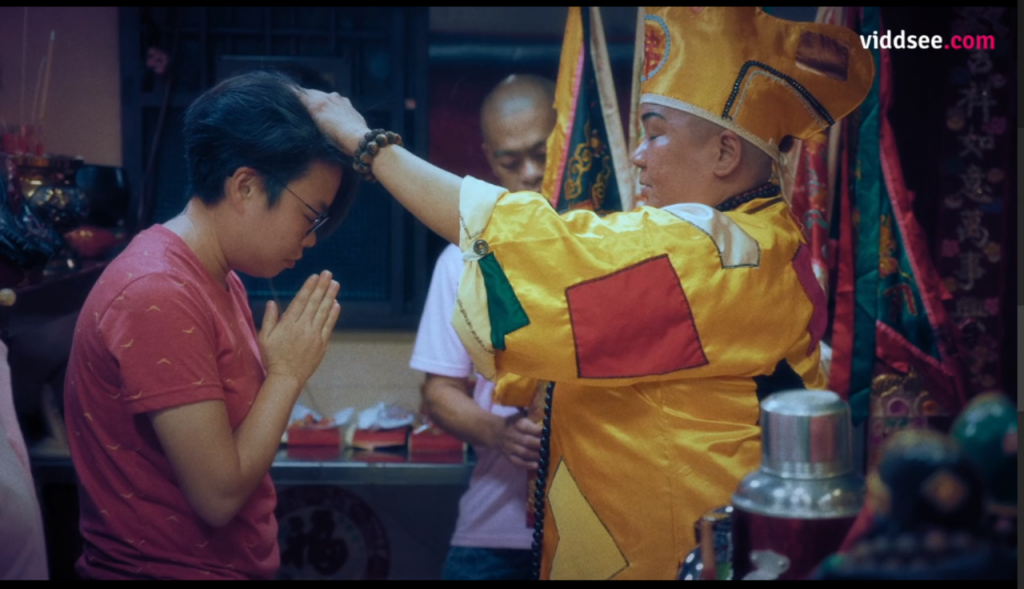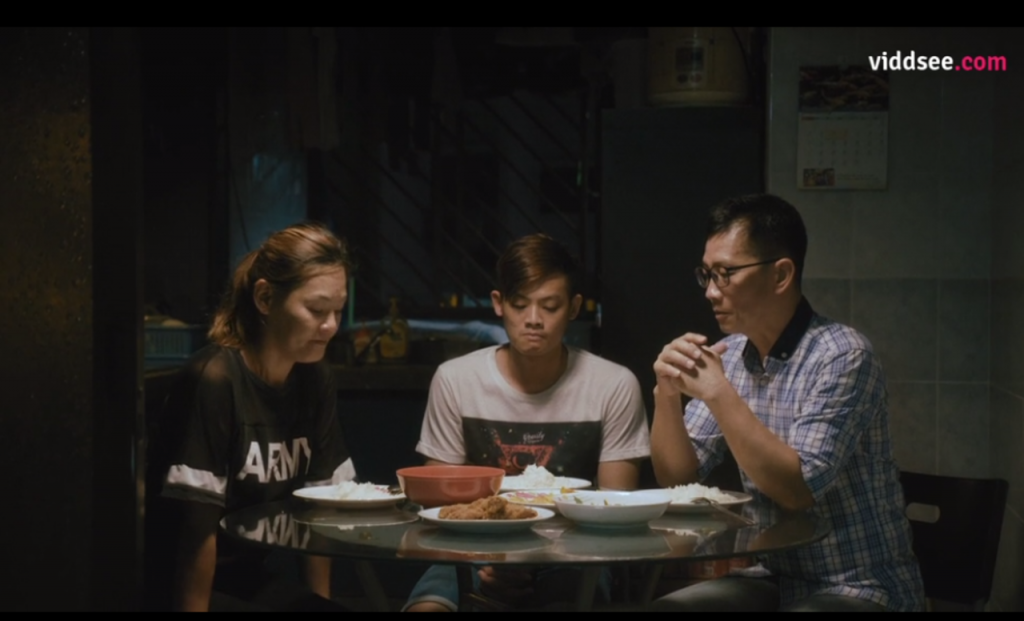All stills from Letters to God.
Top image: Sukaraan, who performs Hindu funeral chanting despite heavy stigma against the profession.
“It all started because I met Steeve. He was driving Grab [at the time], and I took his Grab. I looked at him and the way he dressed, the way he looked, the ornaments he kept in his car, even his face … he was just so different. Like he’s not from this world.”
They got talking. As Eileen took in the man in the driver’s seat—his gleaming head and prominent cheekbones, the way he emanated both peace and pain—he explained how life had brought him behind the wheel.
He’d used to be a businessman, working in a corporate job (“I pictured him as some kind of Wolf of Wall Street type,” quips Eileen) until he left that world behind, seeking grace he didn’t feel he’d earned. A life that wouldn’t leave him feeling bereft, as though the man he saw in the mirror each morning was a stranger.
He decided to become a monk, driving to support himself and make an honest living while he figured things out.
“We exchanged numbers. I kept him in mind, in my EverNote. And when this opportunity came up, he was the first person I had in mind.”
Their conversation became the inspiration for Letters to God, Eileen’s five-part series for online entertainment platform Viddsee. The short films—averaging around 5—6 minutes in length each —profile the spiritual journeys of five Singaporeans from all walks of life: Steeve, a medium, a funeral director, an Indian funeral chanter, and a mother working to rebuild her family after serving time.
“Even thought we’d disconnected for 3 years plus by then, I messaged him hoping he hadn’t changed his number, and luckily he hadn’t,” Eileen continues. “So we met again, and I don’t know if I believe in fate, but when I shook his hand and he looked at me and smiled, and said he remembered me and our conversation, I felt like some things are just too strange to be pure coincidence.”

Letters to God resists such simplification on multiple levels. Short as the films are, there isn’t a clear plotline to them. Some have a more ‘complete’ story arc than others, in the sense that they chronicle the subjects’ transformations—primarily the films featuring Miki, a mother of three who discovered Christianity while in prison, and Steeve.
However, none of them have clear beginnings or ends. While there is sometimes a catalyst for their individual religious awakenings, the films don’t attempt to fit their stories to predetermined ends or themes.
Miki might have resolved to clean up her act and earn her children’s love, respect, and forgiveness, but it’s not apparent that she believes she’s succeeded. Although her story has a clear redemptive arc, having found divine grace does not automatically translate to truly believing she is worthy of it.
Subanna, a portly, jolly spirit medium/aerobics teacher with a luminosity so intense it brightens my day through my screen, realised her connection to the ‘other’ realm at 13, but didn’t fully accept it till she was 38. After all, the abilities that sent clients flocking to her were, and are, the same ones that subjected her to mockery and suspicion; just thinking of this causes her to tear up. For someone purportedly able to commune with divinity, her vulnerability is entirely human.

Places of worship are featured only insofar as they show the subjects at work, such as Steeve discussing monastic orders with a senior monk, or Sukaraan (the funeral chanter) visiting the temple. The subjects don’t explain the rituals they perform; they are simply presented as doing them, in the same way one goes about any of the other myriad rituals of daily life: washing up, getting dressed, walking to the bus stop.
In this vein, God is almost never brought up in conversation. Even Miki, whose story is perhaps the most overtly religious of the bunch, makes only passing reference to her faith (thanking the Lord) as she discusses how she tried to turn her life around.
None of the other subjects address God outright, and none of them bring up faith/theology in any sort of direct sense—what exactly they believe in, their relationship to their god(s), or their opinions about religion per se, are never discussed. There is no proselytising, no veneration of any sort of higher power; we don’t know who God is to the subjects, or what role faith occupies in their life vis-a-vis its other aspects. The word God almost never crosses their lips.
The overall effect of this is twofold. First, religion/spirituality is framed as being incidental to, rather than definitive of, the person in front of the camera. The journeys they undergo are personal ones with a spiritual dimension, not the other way around.
Second, although God is cast as the recipient of the titular letters, it’s never clear who this actually is. As the subjects discuss the loss, hardships, and choices that made them, speaking from an unfiltered first-person perspective, it’s left up to the viewer to decide who is listening.
“I really wanted to keep the concept of God [in this series] hazy, loose … I wanted it to be wider than what society or culture tells us it must be,” Eileen tells me.
“I wanted the humanity of the person to be a lot stronger, because even if someone who didn’t relate to a religion watched it, I wanted them to relate to the person’s journey.”

Both forms have their place, but they are also mainly purposive in nature. Religion is either evaluated against the role it ought to play in a diverse, multi-cultural society, or explained in an educational, informative sense. Both of these are important, but they also produce a curious paradox: that for a subject so rich and transcendent, which speaks to the deepest, most urgent questions of existence, portrayals of religion often end up being tragically soulless—forgoing dimension and nuance in their desire to make a point.
All this makes Letters to God even more unusual: an exploration of religion/spirituality which makes no attempt to define its public role, but is instead nakedly, unabashedly personal.
Much as we laud the diversity of religions in Singapore, we pay much less attention to the immense spectrum of individual religious experience—some of the most significant, and compelling parts of which have nothing to do with religion as it is publicly observed, and everything with how it is lived in private.
The moments of Letters to God which stand out most to me are the most arbitrary, and sometimes ordinary, ones. Subanna dancing alone in a studio, swaying and stomping to the music. Sukaraan recalling how he would sit on his grandfather’s lap as a boy, wrapped in the satisfying embrace of the old man’s complete attention. Tommy, a funeral director who conducts services for elderly folk who die alone, nagging his ageing neighbour to take her medicine.
The range and subtlety of these moments make them hard to pin down, but they are exactly what’s been missing from our screens and newspaper pages. In placing its human subjects front and centre, allowing them to tell their stories without ever judging them for the content, Letters to God covers vastly more ground about faith by saying almost nothing about it.
I ask Eileen what she’d hoped to contribute to the discussion around religion through this series, or, simply, what she felt was missing from it.
“I think what’s missing right now is that people tend to want to define things and think in black and white. What we sometimes miss is the backstory behind why people move towards a certain religion,” was her reply. “The why part … I feel like sometimes we think of it very factually, like God is this way or that way, or I think your God is this way or that way. It’s not very open, not very human.”
“At the end of the day, we’re all the same, we have similar desires … the need for freedom, or redemption, whatever you want to call it. Just that the way we go about finding these things can be different.”

Nonetheless, it was important to her that viewers of all faiths (or none) should be able to identify with the series. When I ask her what she would put in a letter to God, she tells me about an experience she had while making Subanna’s (the medium’s) film.
“I think people relate to God on very different levels. For example, some people think of God as an equal, like a friend, whereas my mum sees God as this superior being that you cannot defy,” she said.
“So I realised that when Subanna is in a trance, people are subservient to her. They treat it like wow, God is here. And me being me … I decided to treat it like I was chatting with a friend, not someone superior to or lower than me. I guess I was cheeky, because if I was really talking to God, I’d want to know what the purpose of life is, like, give me some freaking answers.”
“And it was fucking fun! The response I got was that God was joking with me, telling me ‘zui ba hen tian’ (calling her a sweet-talker), offering me a drink. Which makes me wonder if your perception of God, or how God appears to you, is based on your own psychology.”
Great as the anecdote is, it doesn’t really answer my question—but nor, for that matter, does Letters to God.
A letter is, first and foremost, about communication; some kind of message is being conveyed by a sender to a recipient. Ironically, Letters to God turns this concept on its head by making it unclear who is doing the writing, who is on the other side, reading, and what is being written. If anything, the only definite thing it seems to offer is that religion is not a one-way relationship of unwavering belief, but a complicated, often painful wilderness from which the only way out is human goodness.
Maybe God is in the little things: in the glow of our phone screens; in a quiet evening by the shore; in a stranger on a long, empty bus ride at night, both of you trying to make your way home.
Maybe it’s none of these; maybe it’s all of them. There is no answer, which perhaps is the same thing asked of us by faith: to trust that there is a point to all this where we see none.
Letters to God is available to be streamed on Viddsee. (This post was not sponsored.)
Send us your letters at community@ricemedia.co. We’ll definitely be listening.







